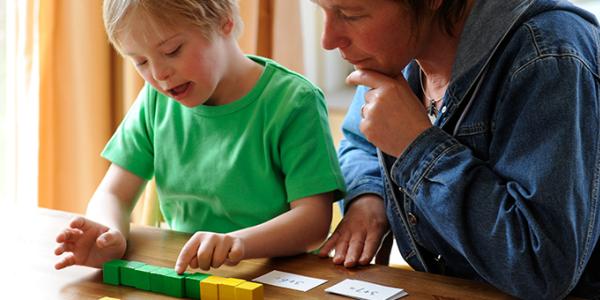Math and Literacy—The Perfect Pair

You are here
Looking for engaging ways to weave math into the day? You might find just what you’re looking for in your home or local library. Many children’s books are perfect for introducing and reinforcing math concepts. Read aloud the books described here and then invite your child to explore the math concepts further. Children will love counting like pigs, measuring like inchworms, and making comparisons.
Pigs Love Potatoes, by Anika Denise. Illus. by Christopher Denise. 2007. Everyone loves potatoes—especially the pig family and their neighbors. One by one Mama adds potatoes to the pot so there will be enough for everyone. Children can count along as they enjoy this delightful rhyming story.
Think of all the things your child can count. Can your child count the different types of shoes in your household with laces? How many forks should be set on the table so that everyone has one at dinner time?
Inch by Inch, by Leo Lionni. [1961] 1995. To avoid being eaten, an inchworm measures a robin’s tail. So begins the story of the inchworm who measures a flamingo’s neck, a toucan’s beak, and a heron’s legs before finally escaping when measuring the nightingale’s song. Use this classic book to introduce the concept of measurement.

Encourage your child to measure objects around your home. They can use both standard measuring tools (rulers and yardsticks) and nonstandard measuring tools (for example, pieces of yarn, hands, feet, shoes, unit blocks, or paper clips). How many inches long is the inchworm book? How many unit blocks long is your child's bed?
More, Fewer, Less, by Tana Hoban. 1998. Using this wordless book, children explore photographs of everyday objects and familiar animals grouped together in interesting ways—by color, size, or texture. For example, one page shows a pile of wrecked cars. The children can decide, Are there more green cars than yellow? More dark green or light green?
Offer an assortment of items to your child and then compare. Provide colorful buttons, cookie cutters of varying shapes, blocks of varying sizes, and so on. Let your child group these objects. Then ask questions to focus thinking on whether there are more, fewer, or less. Are there more red buttons or blue buttons? Which shape cookie cutters are there the fewest of? Are there more large blocks or small blocks?
Source: Adapted from Now Read This, Teaching Young Children 1 (4): 3